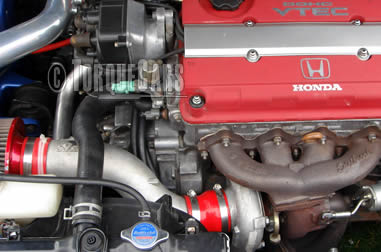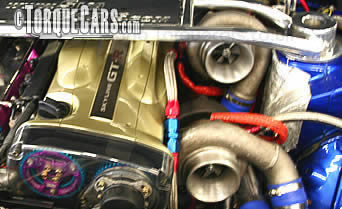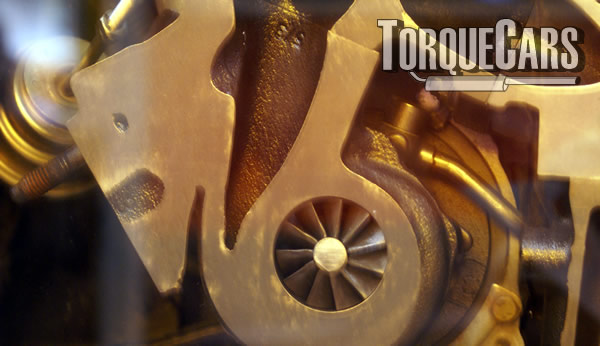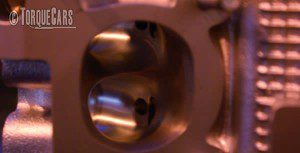Adding an aftermarket turbo to a car.
"You can't just 'bolt on' a turbo, it takes careful planning"
Supercharging an engine involved forcing more air into it through mechanical means by adding a turbo or supercharger.
This is not a straight forward bolt on part, much is required as you will discover from this article.
This is a fairly complex modification and one which keeps cropping up in our forums so we'll cover the basics of adding a turbo upgrade in this article.

The basic reason for forced induction (turbo or supercharger) is not to increase compression or the maximum pressure in an engine cylinder.
Rather the primary reason is to increase volumetric efficiency (the efficiency of the engine at drawing in air) although forced induction is the most effective method of upping compression.
In computer games we just tick a box, and within seconds our car is fully turbocharged and running much faster. In the real world things are very different.
Put a turbo on an engine with an 10:1 compression ratio and watch it go bang!
(Direct injection helps to avoid premature ignition issues, and has been effectively used on modern petrol engines, something they borrowed from diesels.)
There are a lot of considerations to make when adding a turbo to a NASP engine.
How to install a turbocharger on a NASP engine.
Things to take into account when adding a turbo to a non turbo car (NASP or naturally aspirated engine).
If you are thinking of adding a turbo to your car we suggest you join our friendly forum and get some specific tips and advice for your car model.
When a naturally aspirated engine sucks air in, it can only draw so much in before the intake valve closes and seals the cylinder.
The average N/A engine will pull in around 60% of its potential volume, so as a result is only 60% volumetrically efficient. 
The more highly tuned an engine is, the more efficient it will be. A typical TorqueCars member will have already spend much time and effort tuning their NASP engines but will still struggle to get anything approaching 85% efficiency.
With modern ECU's and engine management the efficiency of the engine and drivetrain is always improving as emissions standards get ever tighter.
The latest trend seems to be small capacity engines with turbochargers fitted, with a modern 1.4 turbo putting out as much power as an early 2.0 turbo or 3.0 NASP engine, with much better fuel economy.
The best way to improve this is to force the air/fuel mixture into the cylinders (forced induction) thus filling them more.
The average forced induction engine runs from 110% to 150% volumetric efficiency.
Here are some examples of this to help provide context on the benefits of adding a turbo. A 2 liter NASP motor will use effectively around 1200-1300cc of its capacity and will typically produce up to an optimum 200bhp (based on 100bhp per 1000cc).
A turbocharged or supercharged 2.0 liter engine will use much more of it's capacity, producing more power as it is now able to burn more fuel. (This gives a turbo engine an optimum power figure far in excess of 100bhp per cylinder.)
For example a turbo charged 1.6 engine in a formula 1 application produced well over 1000bhp.
We frequently see 2.0 litre turbo cars hitting 600bhp and more with relative ease providing daily use whilst maintaining reliability. The key is in having a strong block and components to work from.
The more boost you run, the more efficient the engine, hence we have 1.4 litre turbo engines producing as much power as large V6's.
Having a small but powerful engines, gives you a weight advantage too, improving handling and making the power hike even more impressive when driving the car.
But the main benefit from increasing boost is to increase the final compression ratio and getting a better bang from an increased air/fuel charge mix in your cylinders (the actual engines compression ratio stays the same but as there is more air coming into the engine it will become more compressed).
If you increase the amount of air/fuel in the cylinders, then as a result you will increase the compression, which could be too much. In order to keep the final running compression the same, the initial compression (without boost) has to be dropped to compensate.
More air will enable more oxygen to be available for burning and with the addition of additional fuel the engine will release more power.
Turbo charging is the best way to increase the efficiency of an engine.
When adding a turbo to an engine which was not originally designed for a turbo there are some major complications to take into account.
Problems encountered when fitting an aftermarket turbocharger.

Pre-ignition or knock - this is where the fuel ignites under pressure before the spark happens.
This will cause a piston to move in the opposite direction if it has not reached the top dead center and will have disastrous consequences for the engine.
To avoid detonation (premature ignition) you will need to lower the compression ratio of the engine, and/or restrict the turbo to a lower boost threshold. (Low compression engines plus a turbo will also avoid some of the turbo lag problems inherent in most turbo applications.)
The best turbos to add to a non turbo NASP (Naturally aspirated) engine are small units with low boost levels. Remote turbo kits are gaining popularity thanks to the low boost they provide and not needing space in the engine bay.
Another option you have is to fit a water injection kit to dampen the air charge and prevent detonation.
To lower the compression you can go with a re-bore and fit lower compression pistons, you can add a stroker kit to alter the compression ratio or for minor adjustments you could get a larger head and thicker head gasket thus increasing the cylinder size and reducing the compression ratio.
You need to aim for around a 7:1 compression ratio if you are adding a turbo, anything above 9:1 and you will have problems. Modern direct injection engines run much higher compression ratios.
In all cases you should use the highest octane fuel that you can find as the higher the octane the more resistant the fuel is to engine knock.
With the right fuelling though we have seen people running 25psi of boost on a 10:1 compression ratio but we should add that the aftermarket ECU and fuelling mods were of a very high specification on this application.
If you can reduce the boost pressure to 5-7psi (as opposed to 25-35psi), and use the higher octane fuels available (e.g. Shell Optimax) you should be able to run a turbo on a standard engine with around the 9:1 compression ratio. For information on Octane and its effect on engine knock read our octane article.
Direct injection as pioneered on Diesel engines is finding it's way into petrol engines and because the fuel is inject later into the intake charge it reduces the temperature of the charge helping to resist premature ignition.
This is why FSi and Di turbo engines can run very high compression ratios.
Further mods to aid reliability and power

When adding a turbo, for maximum performance gains, you should also get the head flowed, increase the port size, fit bigger valves and go with a larger exhaust header and system as there will be a much larger volume of air flowing through the engine.
Fitting an adjustable boost controller will allow you to experiment on a rolling road while attached to diagnostic equipment to find the optimum boost pressure and timing advance.
Particular attention should be paid to fuelling. More air requires more fuel or you risk the danger of burning too lean.
You also want to avoid overfuelling when the boost from the turbo drops as this can destroy the engine.
On most aftermarket turbo applications it is unlikely that the cars existing fuel delivery system will be able to deliver sufficient fuel so you will need to uprate the fuel pressure with a new pump and fuel pressure regulator, the injectors will also need uprating.
The car computer will also need to take into account the new fuelling requirements of a turbo, especially with regard to throttle position and wastegate control and rapidly changing fuel requirements between on and off boost conditions.
The air intake will also require upgrading, as few OEM air intakes can cope with the air requirements of a 40% power hike.
We strongly recommend a good aftermarket ECU to allow you to create a custom map for your new turbocharged engine.
Most kits contain only the necessary parts to physically get the turbo onto the engine such as an exhaust header and the necessary intake plumbing to the air filter.
Turbos are expensive but will add the most power for your money. You should allow about 40 hours for fitting, you really do need to know what you are doing and will require the ability to create a custom ECU map.
Generally speaking though it will usually be easier to source a turbocharged engine and do a engine transplant to this than add a turbo to a NASP engine.
Most manufacturers now have a turbo charged engine in their line up which would make a suitable donor for your project.
TorqueCars suggest that you join the friendly tuning forum and get some specific tips and advice for turbo charging your car model - we now have a dedicated turbo tuning forum.
If you liked this page please share it with your friends, drop a link to it in your favourite forum or use the bookmarking options to save it to your social media profile.
Check out TorqueCars new YouTube channel, and see their awesome new content...
Feedback
Please use our forums if you wish to ask a tuning question, and please note we do not sell parts or services, we are just an online magazine.
Help us improve, leave a suggestion or tip
5 Responses to “How to add a turbo to a non turbo car.”

Very notifying i also am looking to put a turbo into my 1998 ford mustang v6 3.8 liter were do i even start to build up to it
i build a gt35 watercooled turbo on a toyota mr2 spider (1zzfe).
i am running with all stock,beside the maf converter (apex)..as long i dont go over the 7 psi it is all ok.
last dyno i had 239 hp (stock 138)so..100 ps more with 7 psi..not bad for this light car.the result is i need a extra gear (6 speed..??)
Don’t agree with lowering the CR to 7-1.
I have a 4G63 stroker with 8.7-1 ratio with 18 psi boost780cc injectors and a Haltec computer with a forged bottom end and touch wood zero problems to date 4 years and 15000klm (track and occasional weekend drive)
I have nasp engine with a 10:1 ratio. How much psi would i be able to run? And what injectors should i use?
Can i run turbo with same compression? Thanks julio
low comp turbos are more laggy off boost but can run more boost.
My car has 8.7-1 CR and 17psi